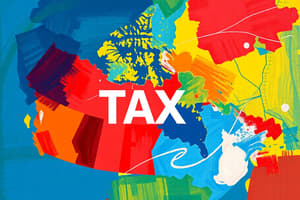Podcast
Questions and Answers
What is the primary effect of lower marginal income tax rates according to economic theory?
What is the primary effect of lower marginal income tax rates according to economic theory?
- Decreased productivity due to longer leisure time
- Higher overall tax revenue from increased spending
- Equal time balance between work and leisure
- Increased time spent at work and decreased leisure time (correct)
Which statement best describes the demand and supply model?
Which statement best describes the demand and supply model?
- It only considers consumer behavior and ignores producers.
- It represents a complex system without assumptions.
- It simplifies market interactions for analytical purposes. (correct)
- It can be applied universally without limitations.
When can the demand and supply model be effectively utilized?
When can the demand and supply model be effectively utilized?
- For examining only government-regulated prices
- When analyzing the behavior of a single consumer only
- In all market conditions regardless of competition
- To study interactions in various market structures (correct)
What role do assumptions play in economic modeling?
What role do assumptions play in economic modeling?
What can be inferred from the statement about reducing the regulatory power of the EPA?
What can be inferred from the statement about reducing the regulatory power of the EPA?
What do consumers seek to maximize given their limited purchasing power?
What do consumers seek to maximize given their limited purchasing power?
In the context of economic decision-making, what role does price play?
In the context of economic decision-making, what role does price play?
Which of the following best describes the primary focus of determining price in microeconomics?
Which of the following best describes the primary focus of determining price in microeconomics?
What is the primary purpose of using theories in economics?
What is the primary purpose of using theories in economics?
What do economists mean by 'empirics'?
What do economists mean by 'empirics'?
How do firms decide on the combination of resources for production?
How do firms decide on the combination of resources for production?
What primary difference does this course focus on compared to introductory courses?
What primary difference does this course focus on compared to introductory courses?
What hypothesis would be evaluated in the study on the economic rewards for studying economics?
What hypothesis would be evaluated in the study on the economic rewards for studying economics?
What does scarcity imply in economic terms?
What does scarcity imply in economic terms?
What are the three key trade-offs that every society faces?
What are the three key trade-offs that every society faces?
What is the role of the price mechanism in a market economy?
What is the role of the price mechanism in a market economy?
What is the relationship between scarcity and trade-offs?
What is the relationship between scarcity and trade-offs?
In microeconomics, what is an economic agent?
In microeconomics, what is an economic agent?
What does the phrase 'a signal wrapped in an incentive' describe?
What does the phrase 'a signal wrapped in an incentive' describe?
Which statement best reflects the limitations of economic models?
Which statement best reflects the limitations of economic models?
What distinguishes positive analysis from normative analysis in economics?
What distinguishes positive analysis from normative analysis in economics?
What is the expected wage difference between economics majors and education majors?
What is the expected wage difference between economics majors and education majors?
Which of the following statements is a positive statement?
Which of the following statements is a positive statement?
What is the general consensus about tariffs and import quotas among economists?
What is the general consensus about tariffs and import quotas among economists?
How do economics majors' earnings compare to those of chemistry, math, and physics majors?
How do economics majors' earnings compare to those of chemistry, math, and physics majors?
Which of the following propositions had the lowest percentage of economists agreeing?
Which of the following propositions had the lowest percentage of economists agreeing?
Which statement exemplifies a normative economic analysis?
Which statement exemplifies a normative economic analysis?
In the context of earnings, how do economics majors perform compared to engineering majors?
In the context of earnings, how do economics majors perform compared to engineering majors?
Which statement illustrates a common misconception regarding public assistance?
Which statement illustrates a common misconception regarding public assistance?
Flashcards
What is an economic model?
What is an economic model?
A representation of a theory, using a simplified description that can be logical and easy to understand. These descriptions can come in the form of words, pictures, or mathematical expressions. The art of creating these descriptions is achieved by making specific assumptions.
Demand and Supply Model
Demand and Supply Model
The simplified framework that helps us understand how prices are determined and how quantities of goods and services are bought and sold in an economy.
What is Consumer Theory?
What is Consumer Theory?
Understanding what influences consumer decisions and what factors drive their purchases.
What is Producer Theory?
What is Producer Theory?
Signup and view all the flashcards
When is a market a good model to use?
When is a market a good model to use?
Signup and view all the flashcards
What is Microeconomics?
What is Microeconomics?
Signup and view all the flashcards
What is Scarcity?
What is Scarcity?
Signup and view all the flashcards
What is a Trade-off?
What is a Trade-off?
Signup and view all the flashcards
What are the 3 Key Trade-offs?
What are the 3 Key Trade-offs?
Signup and view all the flashcards
What is the Price Mechanism?
What is the Price Mechanism?
Signup and view all the flashcards
What is Positive Analysis?
What is Positive Analysis?
Signup and view all the flashcards
What is Normative Analysis?
What is Normative Analysis?
Signup and view all the flashcards
Positive statement
Positive statement
Signup and view all the flashcards
Normative statement
Normative statement
Signup and view all the flashcards
Microeconomics
Microeconomics
Signup and view all the flashcards
Macroeconomics
Macroeconomics
Signup and view all the flashcards
Normative analysis
Normative analysis
Signup and view all the flashcards
Positive analysis
Positive analysis
Signup and view all the flashcards
Market analysis
Market analysis
Signup and view all the flashcards
Economist agreement
Economist agreement
Signup and view all the flashcards
Main Theme #1: Scarcity and Optimization
Main Theme #1: Scarcity and Optimization
Signup and view all the flashcards
Main Theme #2: Price Matters
Main Theme #2: Price Matters
Signup and view all the flashcards
Beyond Supply & Demand
Beyond Supply & Demand
Signup and view all the flashcards
Economic Model
Economic Model
Signup and view all the flashcards
Economic Hypothesis
Economic Hypothesis
Signup and view all the flashcards
Empirics in Economics
Empirics in Economics
Signup and view all the flashcards
Testing Economic Theories
Testing Economic Theories
Signup and view all the flashcards
Example: Economic Reward of Studying Economics
Example: Economic Reward of Studying Economics
Signup and view all the flashcards
Study Notes
Cornell Method for Note-Taking
- The Cornell Method is recommended for taking notes during lectures and reading
- Use a page divided into sections: Cue column, Note-taking column, and Summary
- Record key terms, questions, and main ideas in the Cue column
- Record detailed notes, diagrams, and formulas in the Note-taking column
- Summarize the notes in your own words in the Summary section
Intermediate Microeconomic Theory
- The course covers the relationship between scarcity, trade-offs, and decision-making
- It examines the three key trade-offs faced by every society
- It explains the fundamental role of price in a market economy
What is Microeconomics?
- Microeconomics studies the behavior of individual economic agents, like consumers and firms.
Scarcity
- Scarcity is a fundamental economic concept
- Resources are limited, while wants are unlimited
- This creates a need for trade-offs
Trade-offs
- Trade-offs are decisions made because of scarcity
- Choosing one option means foregoing another
The Bigger Picture - the What, How, and Who?
- Scarcity of resources forces societies to make choices about production, consumption, and distribution of goods
Perfect Competition
- A market structure in which producers are price takers
- Assumptions include many small producers, no barriers to entry, homogenous goods
Price Mechanism
- Price acts as a signal in market economies
- Price directs resources to where they are most valued
- Price motivates incentives for both production and consumption
Economic Models
- Models are simplified representations of reality
- Economists use models to understand economic phenomena and make predictions
- Models help to isolate variables and simplify complex interactions
Positive vs. Normative Analysis
- Positive statements describe "what is" (facts, data)
- Normative statements express values, opinions, or "what ought to be"
Main Themes in Intermediate Microeconomic Theory
- Main theme #1: Economic agents make themselves as well off as possible given limited resources
- Main theme #2: Price is crucial in decision-making and economic interactions
- Main theme #3: Economists use theories, models, and empirical evidence for analysis
Models: Representation of a Theory
- Economists represent theories through verbal, visual or mathematical descriptions
- Models have logical and simplified descriptions of economic interactions
- Models include specific assumptions
Why is this so Important?
- Studying demand and supply is essential in microeconomic theory
- Students should understand the theories behind demand and supply
Real World is Complex
- The real-world is significantly more complex than simple models can reflect
What is a Market?
- Markets are central to economic study, typically involving a specific product, location, and time period
- Markets connect consumers and producers through price as a signal
Key Assumptions and Analysis
- Perfectly competitive markets have implicit assumptions about the agents, good, information, and institutions.
- Analysis of models explores when the model assumptions hold, and when it can be used to help make predictions
When to Use the Model
- Models provide predictions about demand and supply shocks and the impact of policy
- Useful in various markets: agriculture, finance, labor, etc.
Studying That Suits You
Use AI to generate personalized quizzes and flashcards to suit your learning preferences.




